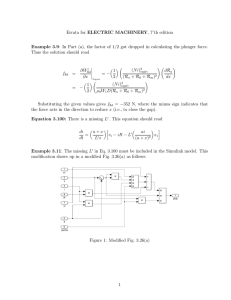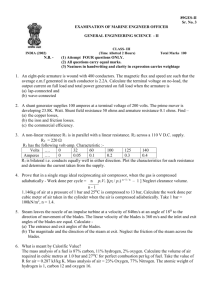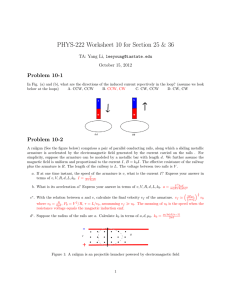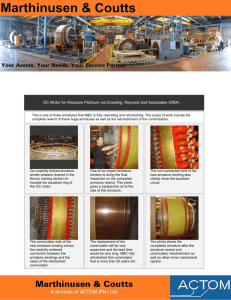IL = If = Ia = P/Vt = 10000/230 = 43.48A, but Ea = Vt +
advertisement
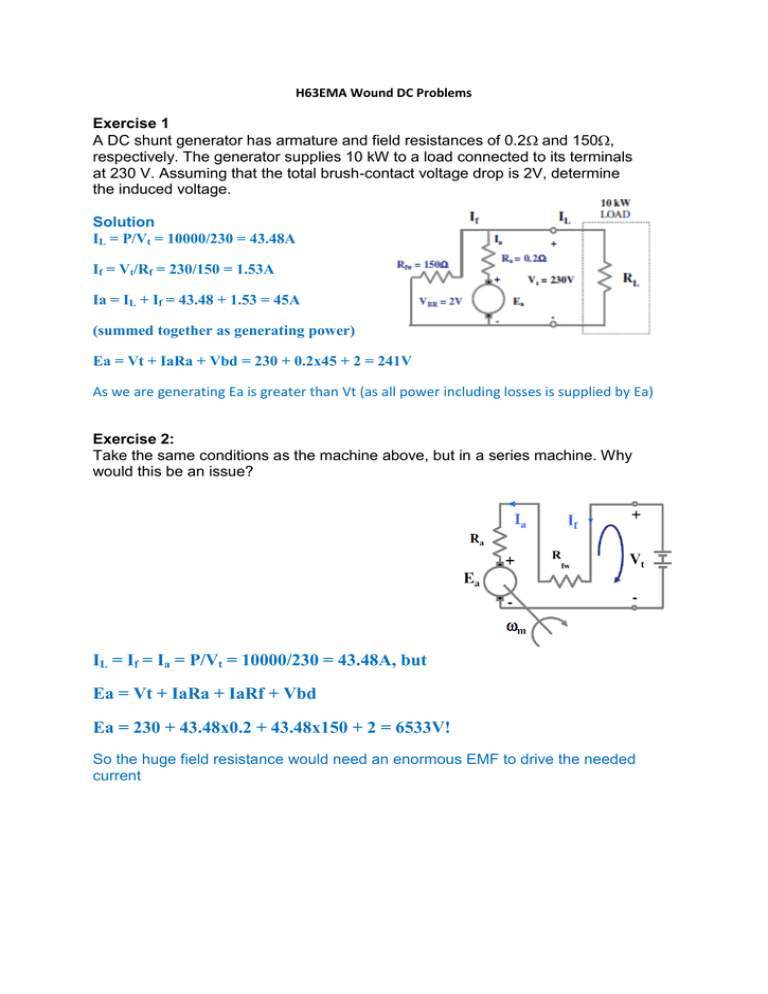
H63EMA Wound DC Problems Exercise 1 A DC shunt generator has armature and field resistances of 0.2and 150, respectively. The generator supplies 10 kW to a load connected to its terminals at 230 V. Assuming that the total brush-contact voltage drop is 2V, determine the induced voltage. Solution IL = P/Vt = 10000/230 = 43.48A If = Vt/Rf = 230/150 = 1.53A Ia = IL + If = 43.48 + 1.53 = 45A (summed together as generating power) Ea = Vt + IaRa + Vbd = 230 + 0.2x45 + 2 = 241V As we are generating Ea is greater than Vt (as all power including losses is supplied by Ea) Exercise 2: Take the same conditions as the machine above, but in a series machine. Why would this be an issue? R fw IL = If = Ia = P/Vt = 10000/230 = 43.48A, but Ea = Vt + IaRa + IaRf + Vbd Ea = 230 + 43.48x0.2 + 43.48x150 + 2 = 6533V! So the huge field resistance would need an enormous EMF to drive the needed current Exercise 3: A separately excited motor runs at 1045 rpm, with constant field current and an armature current of 50A at 120V. The armature resistance is 0.1ohm. The motor is further loaded such that it draws a current of 95A at 120V. 1. What is the motor speed at this load? What is the power and torque delivered? 2. If the armature voltage is now increased to 180V and the load torque remains the same, what is the new speed of the machine? 3. If the field current is reduced by 25% what will the armature current and speed of the motor be for the same torque and armature voltage above? Solution 1. What is the motor speed at this load? What is the power and torque delivered? V1=V2 = 120 V; Ra =0.1 Ω; Ia1=50 A; Ia2=95 A; N1=1045 rpm. ω1=N1*2π/60 E1=V1 – Ra∙Ia1 = 120 – 0.1x50 = 115V E2=V2 – Ra∙Ia2 = 120 – 0.1x95 = 110.5V Provided that the field current remains constant and that there is no armature reaction effect: Ea = KaIfm, If and Ka are constant so m must vary in proportion with Ea ω2/ω1 = E2/E1 → ω2 = ω1*E2/E1 = 105.15 rad/s or N2= ω2*60/2π= 1004 rpm Pem2 = E2* Ia2 = 10,500 W P = Tω T2=P2/ ω2 = 99.84 Nm. 2. If the armature voltage is now increased to 180V and the load torque remains the same, what is the new speed of the machine? V3 = 180V; Ia3 = I2 = 95 A E3 = V3 – Ra∙Ia3 = 170.5 V ω3 = ω1*E3/E1 = 162.25 rad/s . N3= ω3*60/2π= 1549 rpm 3. If the field current is reduced by 25% what will the armature current and speed of the motor be for the same torque and armature voltage above? V4 = V3 = 180V Torque is the same as in case 2 and 3 (T4 = T2 = 99.84) so a decrease in If has to be compensated by an increase in Ia to keep the same torque, as T = KaIfIa Ia4 = 4/3 * Ia3 = 126.67 A E4=V4 – Ra∙Ia4 = 167.33 V E4*Ia4 = T4* ω4 → ω4 = E4*Ia4/T4 = 212.29 rad/s. N4= ω4*60/2π = 2027.3 rpm Note that the EMF constant changes due to the change in the field current ( 𝐸4𝜔4≠𝐸3𝜔3) Exercise 4: The armature winding of a 4-pole, DC machine is lap-wound in 46 slots with 18 conductors per slot. The field poles span 70% of the pole pitch and the peak air gap flux density from them is 0.7T. The machine has an air gap diameter of 15cm and a core axial length of 25cm. 1. If the armature is designed to carry a continuous line current of 100A, what is the maximum electromagnetic torque developed by the machine? 2. Calculate the voltage induced in the armature winding when the rotor speed is 1800 rpm. 3. If the machine is supplied from a constant DC voltage source of 380V and the armature resistance Ra=0.5ohm, what is the rotor speed if a load of 20Nm is applied? State any assumptions made. Solution P = 2 (2 pole pairs/4 poles), N = 46, Z = 18, B = 0.7T, fp = 0.7, D = 0.15m, L = 0.25m, lap wound 1. If Ia = 100A As lap wound: Cond current = Iw = 100/(2P) = 25A Current loading = A = IWNZ /(pi D) = 25x46x18/(x0.15) = 4.393x104A/m T=2 fp B A (L ( D2)/4) = 2x0.7x0.7x4.393x104x(0.25(x0.152)/4) = 190.2Nm 2. At 1800 RPM = 2xRPM/60 = 188.5rad/s EaxIa = Tx, Ea = Tx/Ia = 190.2x188.5/100 = 358.5V Neglecting brush voltage drop and iron non-linearity, Ra = 0.5, Vt = 380V, load = 20Nm Ia@20Nm = Ia/T x 20 = 100/190.2x20 = 10.52A Ea@20Nm = Vt - Ia@20Nm x Ra = 380 – 10.52x0.5 = 374.7V RPM@20Nm = RPM/Ea x Ea@20Nm = 1800/358.5x374.7 = 1881rpm
